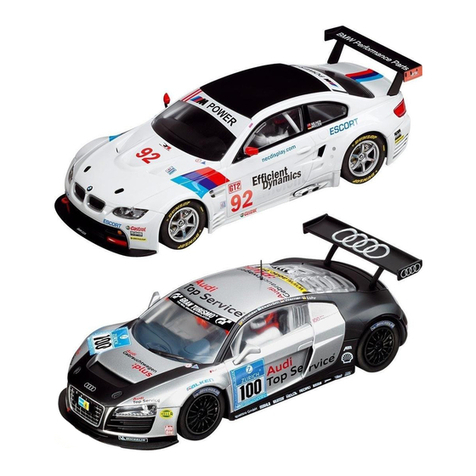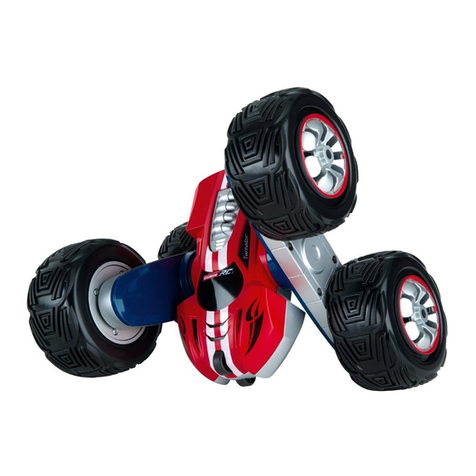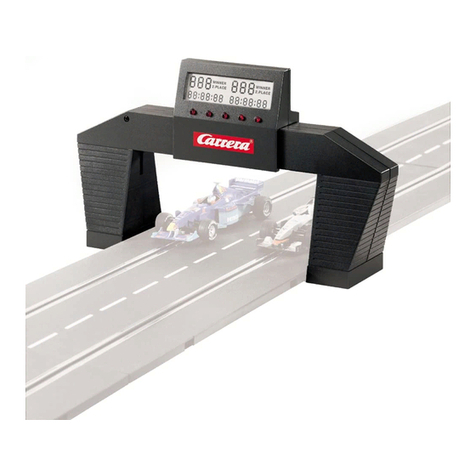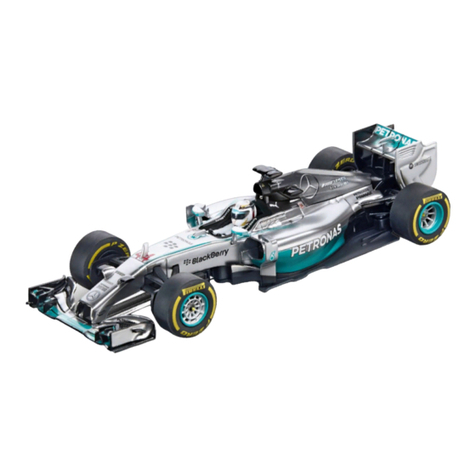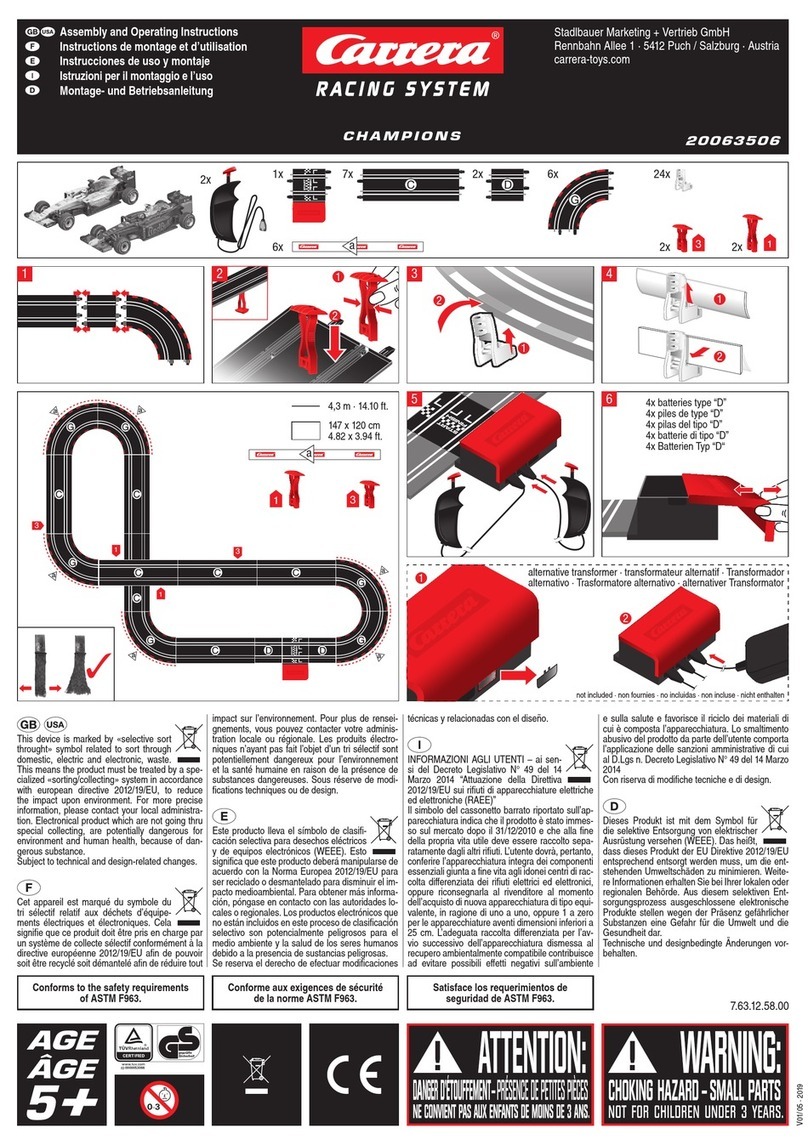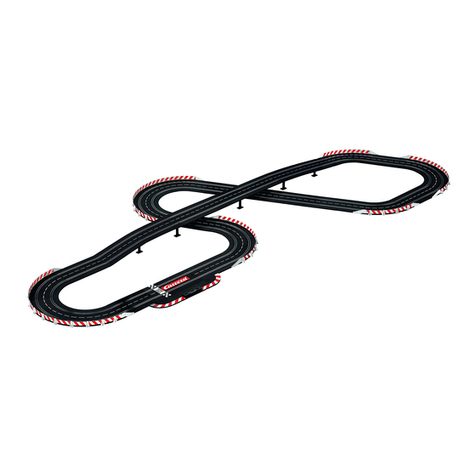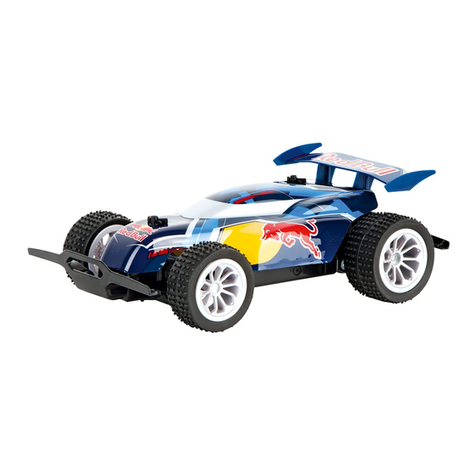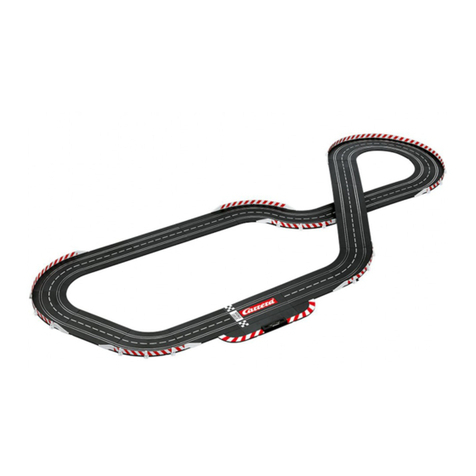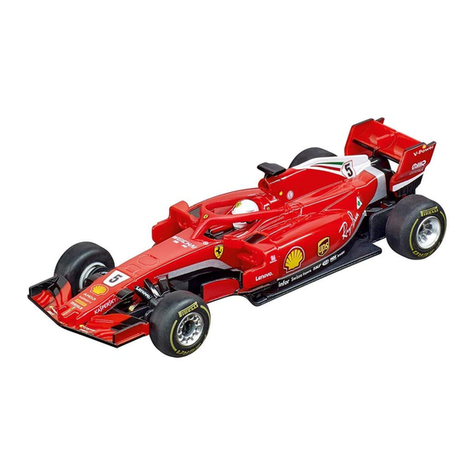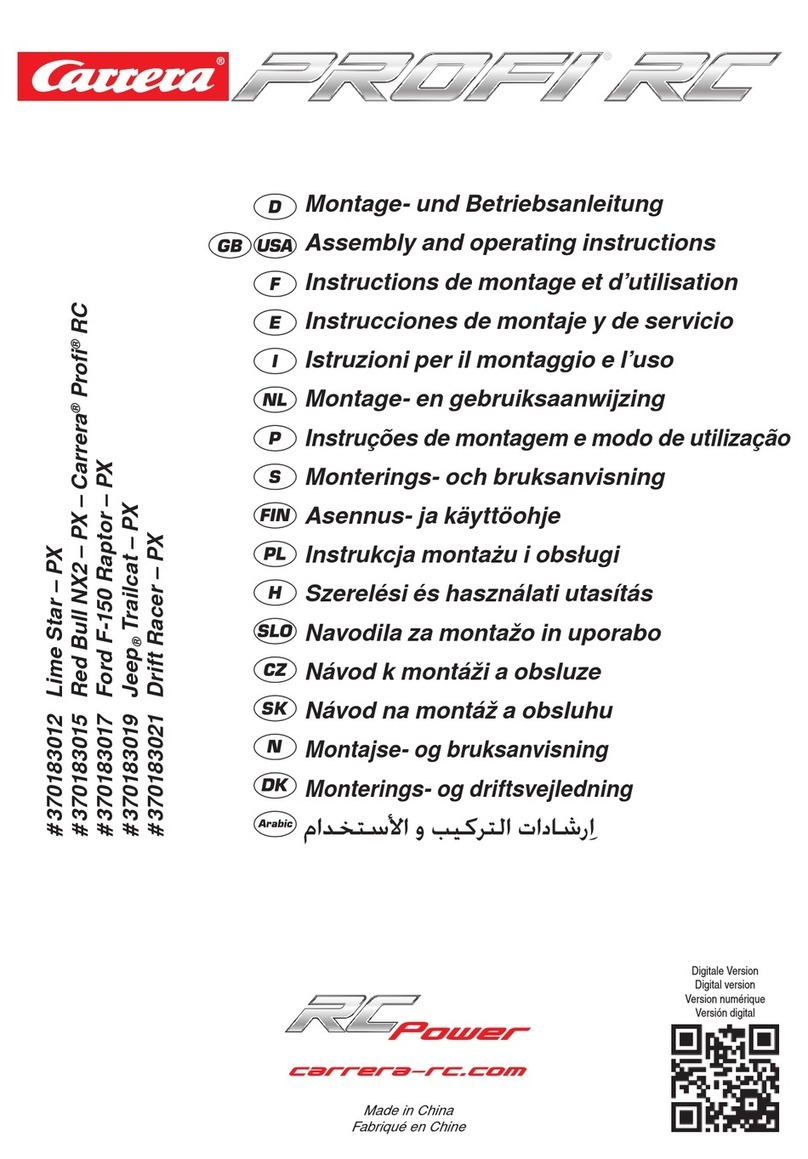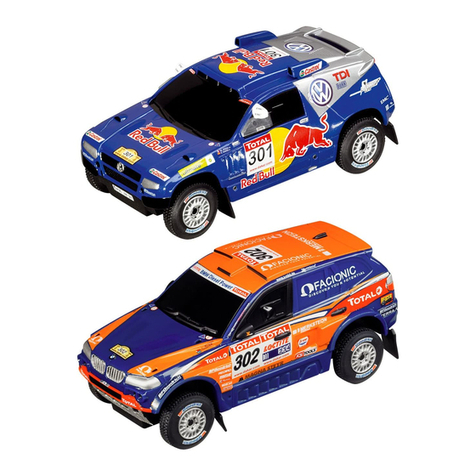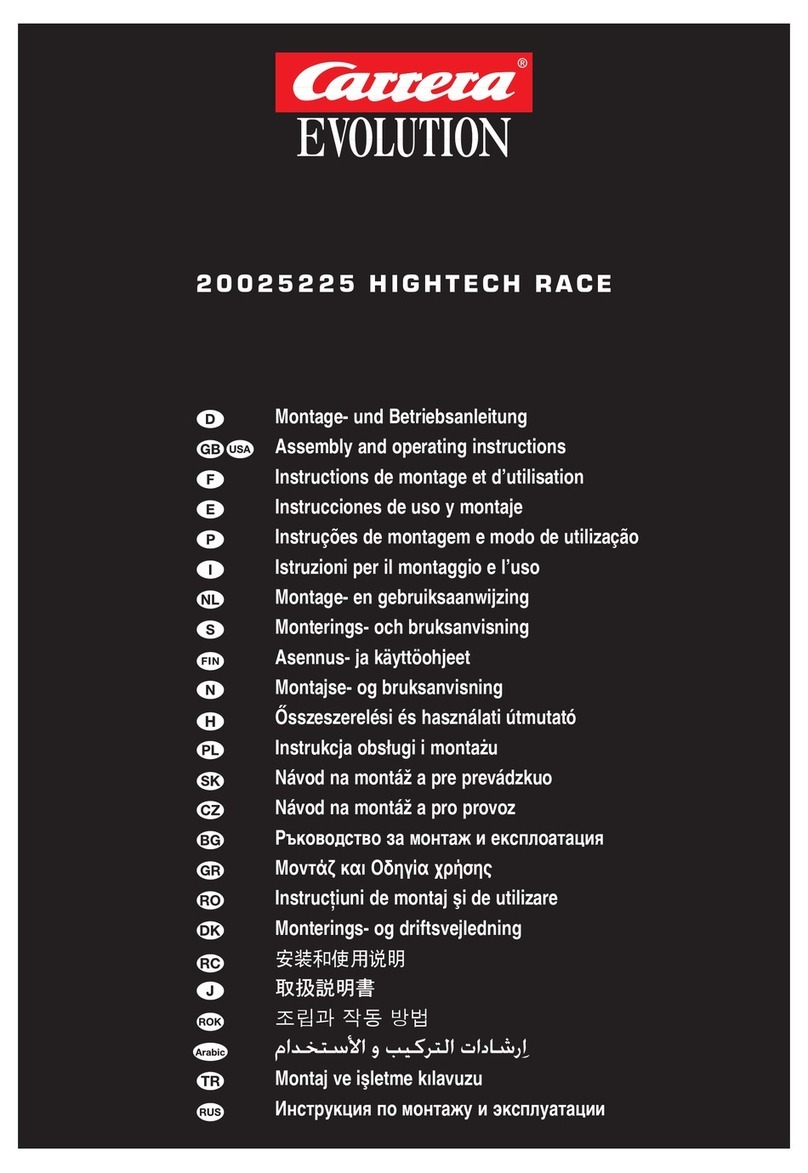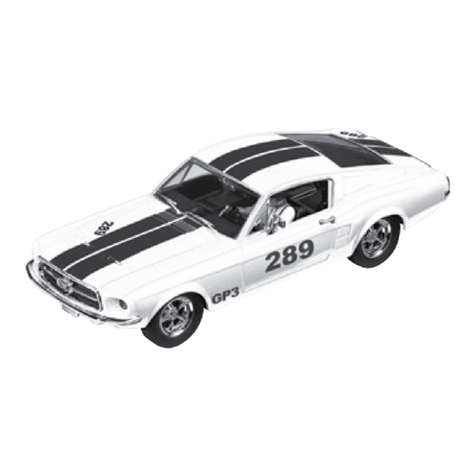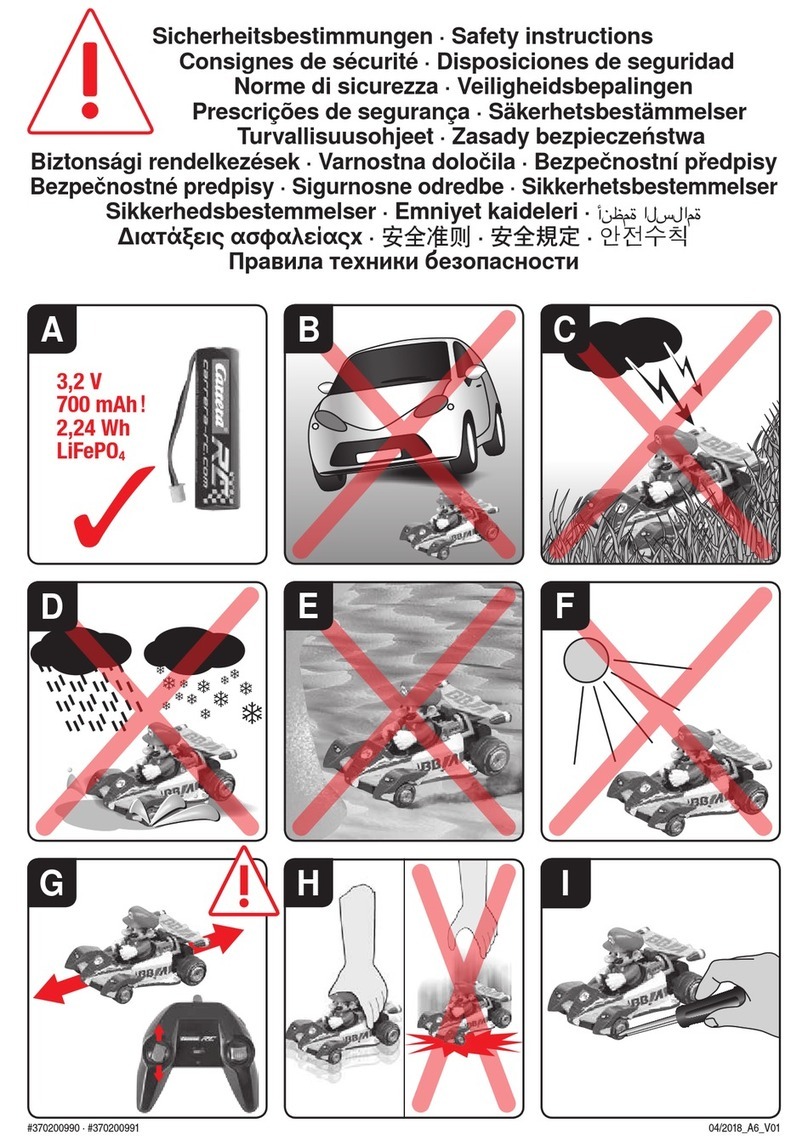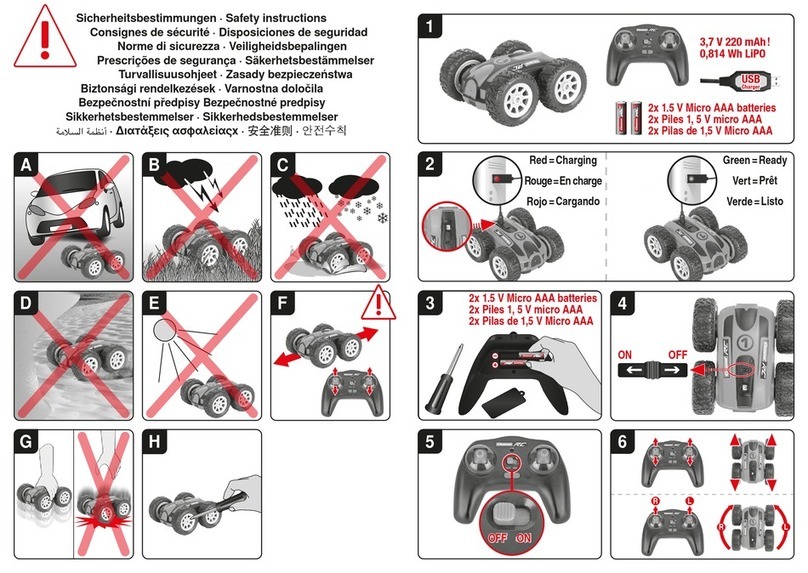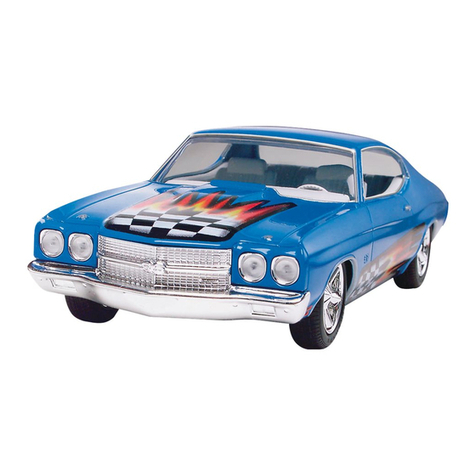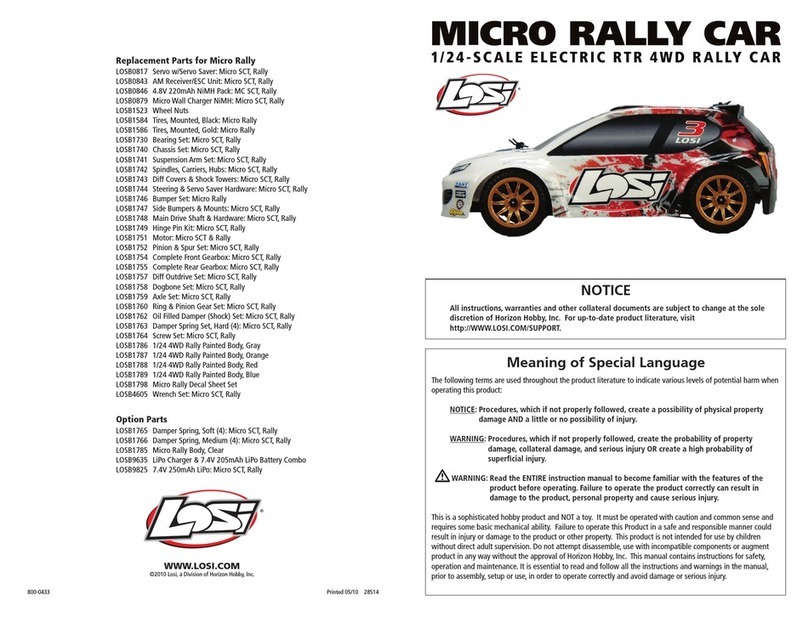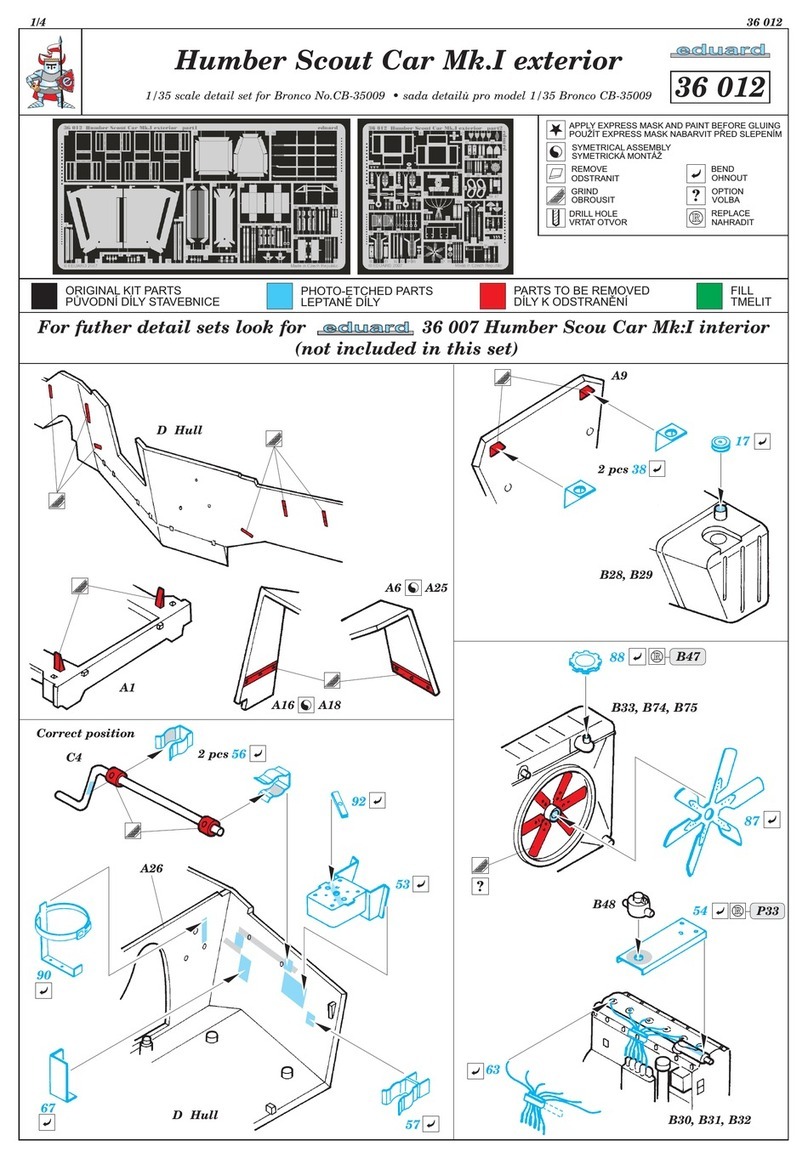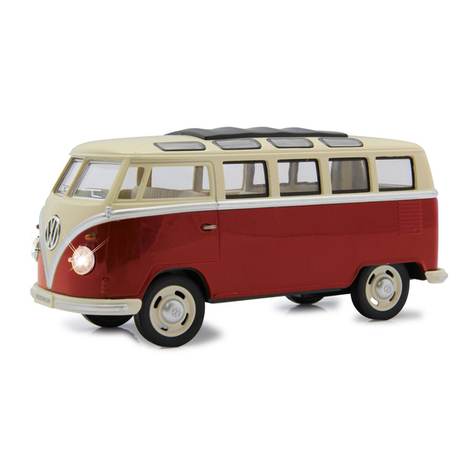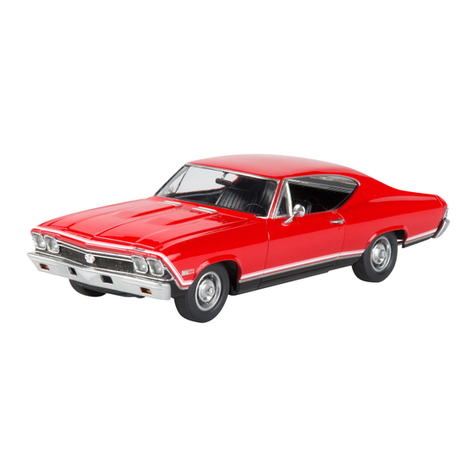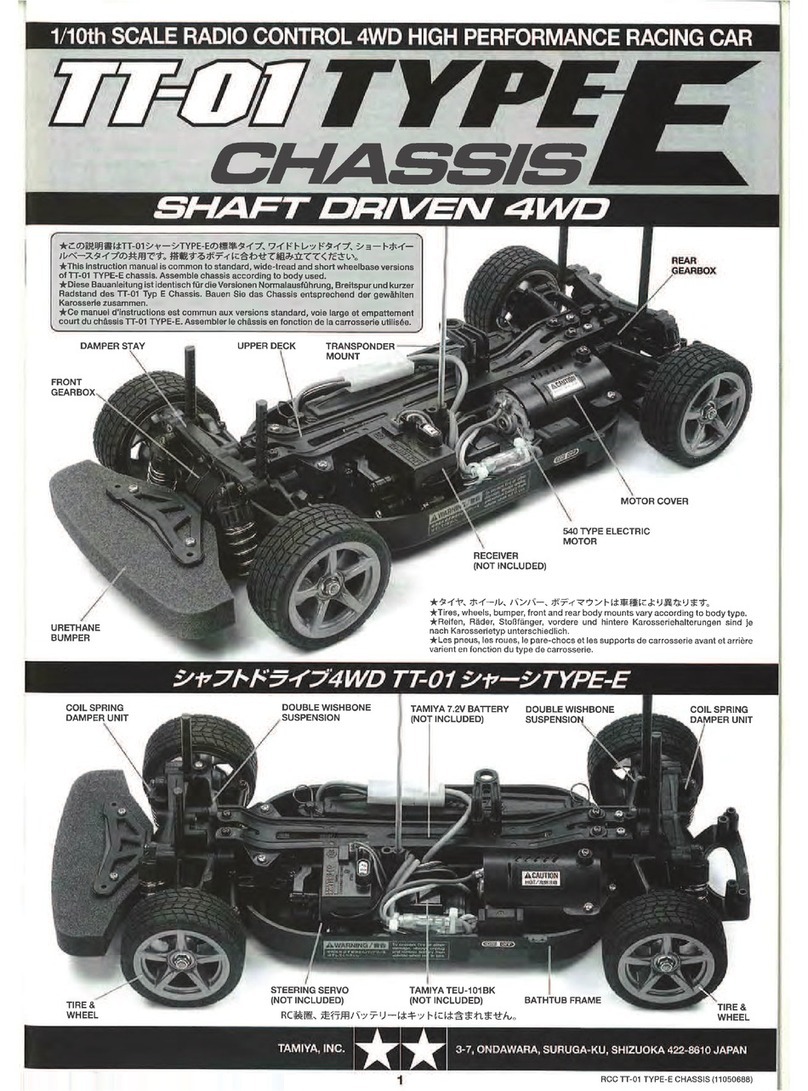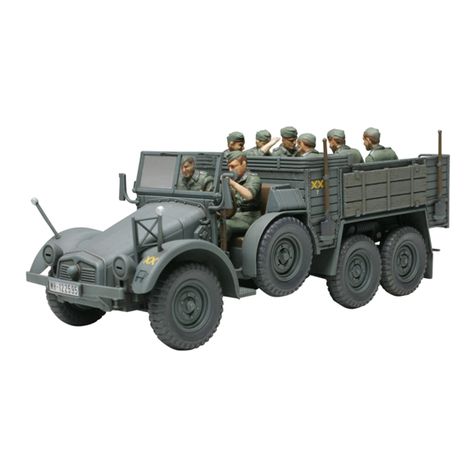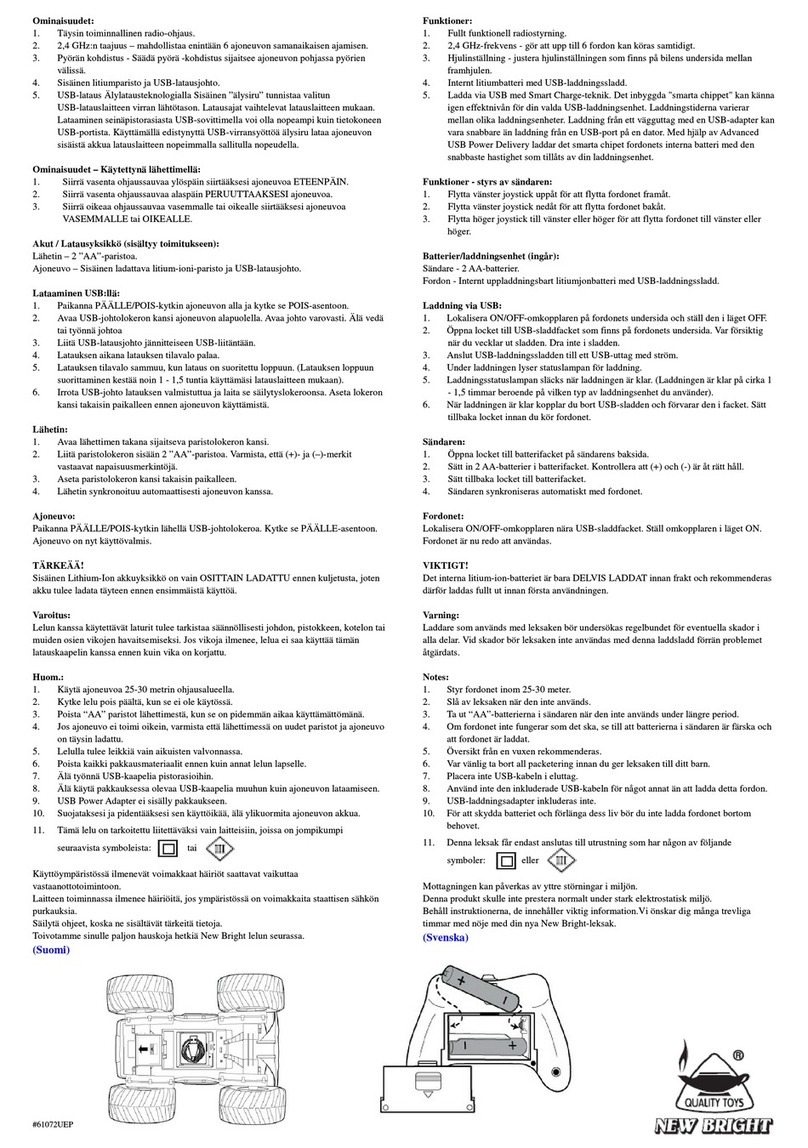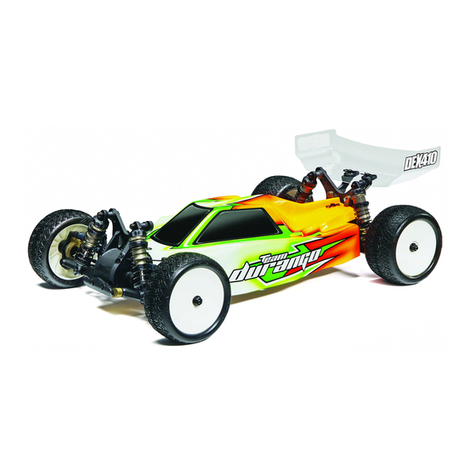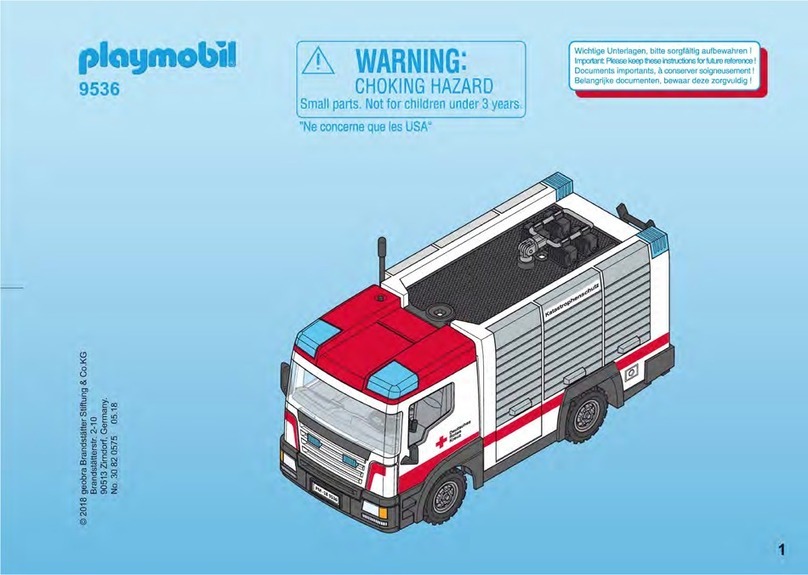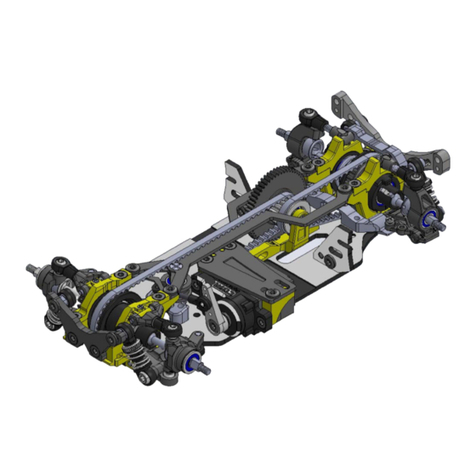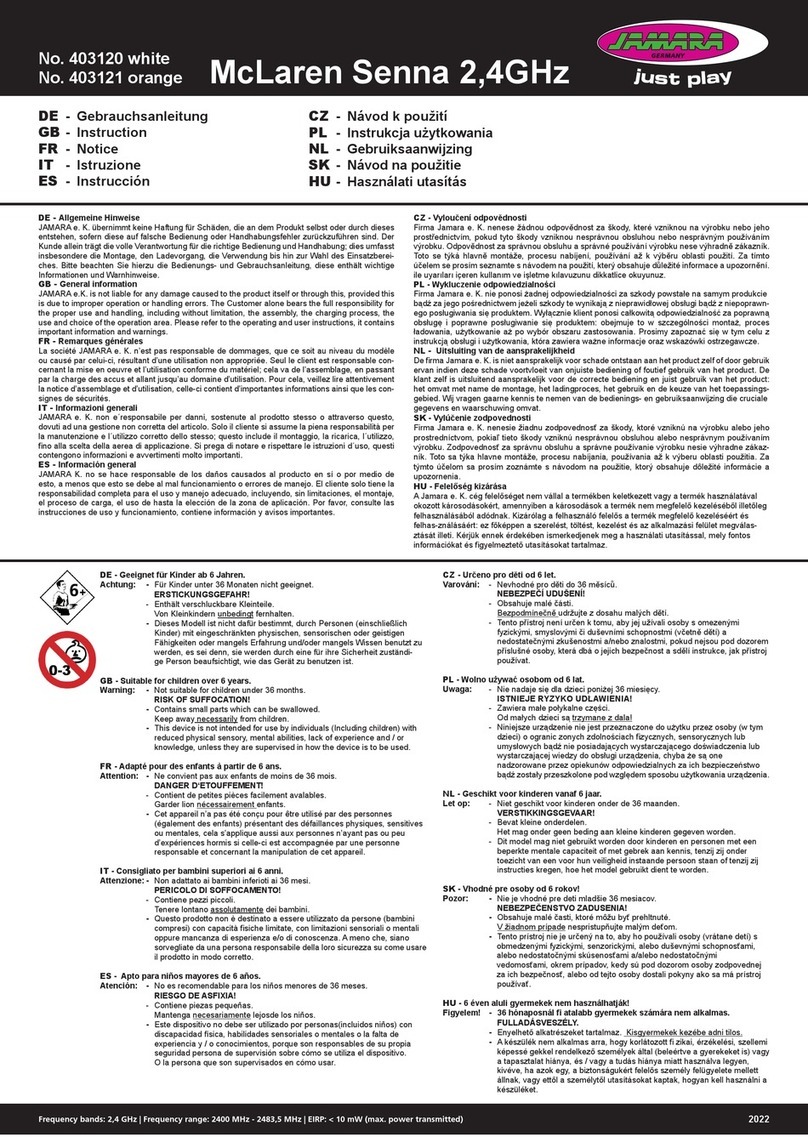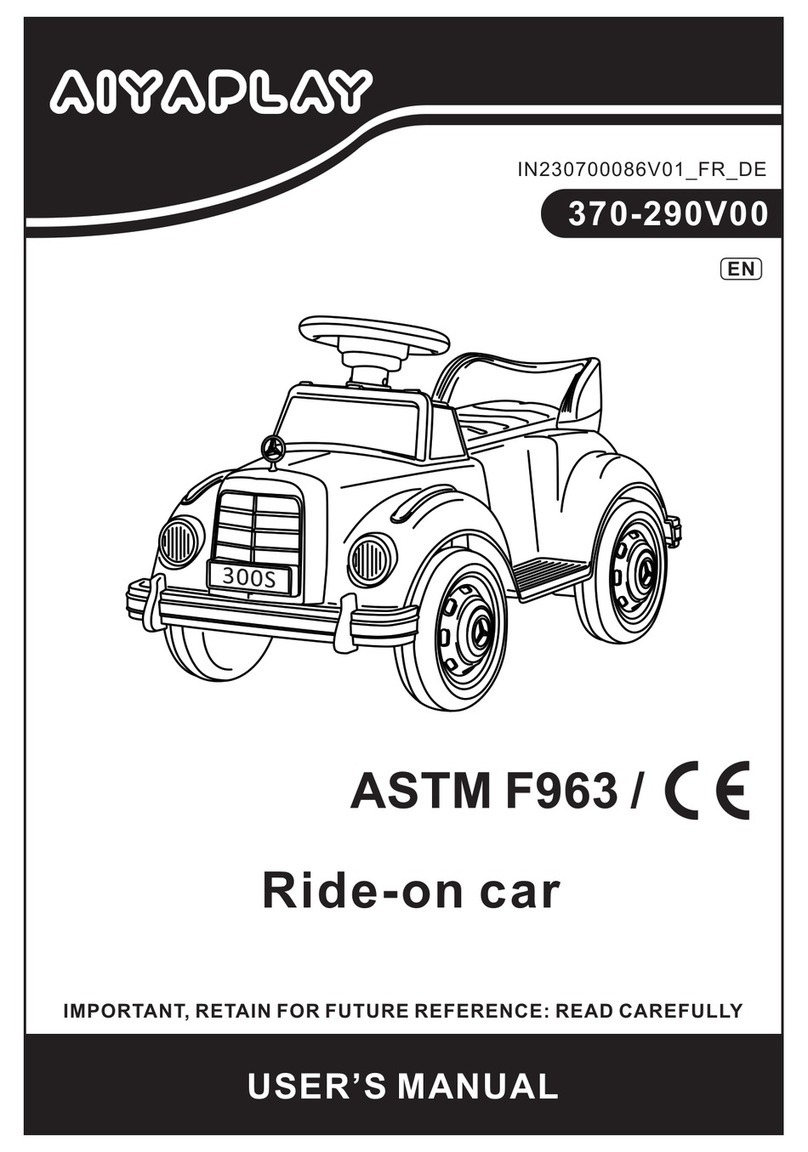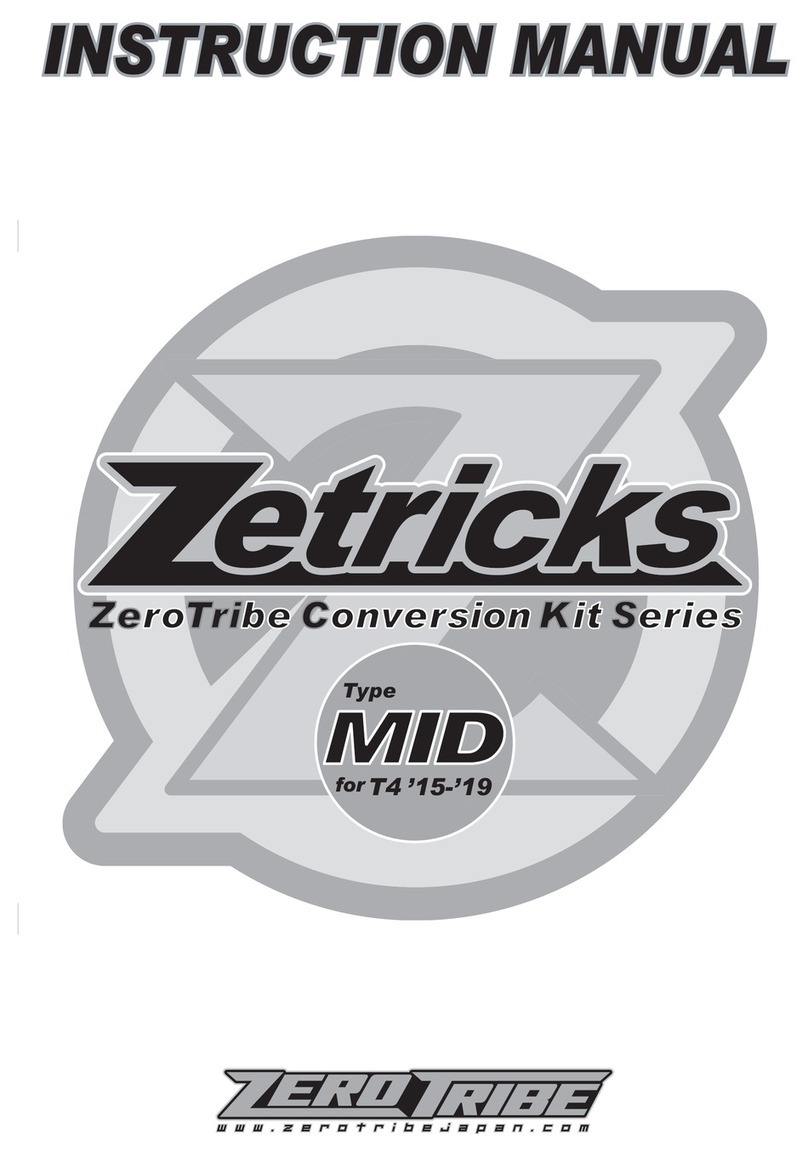Energy-saving mode
After 20 minutes of non-usage the Control Unit switches to ener-
gy-saving mode and all displays such as Position Tower, Driver
Displays and Startlight are turned off. To reactivate the controller,
switch it off for 2 or 3 seconds, then switch it on again. All settings
will be kept.
Replacement of double sliding
contact and guide keel
2 a 2 b
1
Advice:
• It is recommended to always take out and change only one grinder.
• Never pull the vehicle backwards, because the grinders could be
damaged otherwise.
1 Please carefully pull out the guide keel according to fig. 1.
2 When changing the double contact brushes please take care
that in stage one the upper contact brush 2 a is only pulled out
partly and that in stage two the double contact brush can be pulled
out completely with the contact brush 2 b. For inserting please
proceed the same way.
Maintenance and care
1
2
To ensure a proper operation of the motor-racing circuit, all racetrack
components should be regularly cleaned. Pull the plug prior to cleaning.
1 Racetrack: Keep the track surface and track slots clean with a
dry cloth. Do not use any solvents or chemicals for cleaning. When
it is not in use, store the racetrack in a clean and dust-protected
location, preferably in the original cardboard box.
2 Car check: Clean axle and wheel bearings, pinion gears, gear-
wheels and bearings and lubricate using a resin- and acid-free
grease. You can use a toothpick or similar as aid. Regularly check
the condition of sliding contacts and tyres.
Troubleshooting
Driving tips
Troubleshooting:
In case of any malfunctions, please check the following:
• Has the connection to the power supply been established correctly?
• Have transformer and speed controllers been connected correctly?
• Are the track connections faultless?
• Are the racetrack and track slots clean and free of any foreign objects?
• Are the sliding contacts in order and do they make contact with the
track slot?
• Are the cars correctly coded to the according speed controller?
• The track‘s current feed will be switched off automatically for 5 seconds,
if there is an electrical short circuit: this will be notified by audible and
visual signals.
• Are the cars placed on the track in running direction? In case of non-
functioning push the running direction switch which is on the car´s bottom.
• Is the adapter unit correctly installed facing the direction of travel?
• Is the speed controller battery properly connected?
• Is the battery fully charged?
• Does the LED on the controller flash while charging?
• Is the speed controller bound to the receiver?
• Has the speed controller got a duplicate address assignment?
Note:
During operation small car parts as spoilers or mirrors may get off or
brake due to being original detailed parts of the car model. To avoid this
it is possible to remove them before operation.
Driving technique:
• You can drive fast along the straight track but you should brake before
the curve and then accelerate again when coming out of the curve.
• Do not fasten or block the vehicles when the motor is running: over-
heating or damage to the motor could result otherwise.
Note: When using track systems which are not manufactured by Car-
rera the existing guide keel has to be replaced by the special guide
keel (#20085309). While using the Carrera crossing (#20020587) or
high banked curve 1/30° (#20020574) slight driving noise might occur
which is due to the full-scale genuineness and does not affect flawless
operation.
Technical specifications
Output voltage: Toy transformer
14,8 V 51,8 VA
Lithium polymer rechargeable battery: 3,7 150mAh · 0,55 Wh
Maximum charging time: 2 hours
Frequency: 2.4 GHz
Frequency band: 2400-2483.5 MHz
Transmission power: maximum 10 mW
Electricity modes:
1.) Operating mode = cars are operated via speed controllers
2.) Idle mode = speed controllers not activated, no game
3.) Stand-by mode = after approx. 20 minutes idle mode the
connecting section switches to stand-by mode.
The LED is no longer lit.
CURRENT CONSUMPTION < 0,5 watt / 0,5w
To reactivate the controller, switch it off for 2 or 3 seconds, then
switch it on again. The racetrack is then once again in standby mode.
4.) Off-state = power supply unit disconnected from mains supply
This device is marked by “selective sort throught” symbol related to
sort through domestic, electric and electronic, waste. This means
the product must be treated by a specialized “sorting/collecting” sys-
tem in accordance with European directive 2012/19/EU, to reduce
the impact upon environment. For more precise information, please
contact your local administration. Electronical product which are
not going through special collecting, are potentially dangerous for
environment and human health, because of dangerous substance.
Output voltage: Toy transformer
14,8 V 42,9 VA
Lithium polymer rechargeable battery: 3,7 150mAh · 0,55 Wh
Maximum charging time: 2 hours
Frequency: 2.4 GHz
Frequency band: 2400-2483.5 MHz
Transmission power: maximum 10 mW
Electricity modes:
1.) Operating mode = cars are operated via speed controllers
2.) Idle mode = speed controllers not activated, no game
3.) Stand-by mode = after approx. 20 minutes idle mode the
connecting section switches to stand-by mode.
The LED is no longer lit.
CURRENT CONSUMPTION < 0,5 watt / 0,5w
To reactivate the controller, switch it off for 2 or 3 seconds, then
switch it on again. The racetrack is then once again in standby mode.
4.) Off-state = power supply unit disconnected from mains supply
Conforms to the safety requirements of ASTM F963.
Requirement for FCC Part 15
Warning: Changes or modifications not expressly approved
by the party responsible for compliance could void the user’s
authority to operate the equipment.
Note: This equipment has been tested and found to comply with
the limits for a Class B digital device, pursuant to Part 15 of the
FCC Rules. These limits are designed to provide reasonable pro-
tection against harmful interference in a residential installation. This
equipment generates, uses and can radiate radio frequency energy
and, if not installed and used in accordance with the instructions,
may cause harmful interference to radio communications. However,
there is no guarantee that interference will not occur in a particular
installation. If this equipment does cause harmful interference to ra-
dio or television reception, which can be determined by turning the
equipment off and on, the user is encouraged to try to correct the
interference by one or more of the following measures:
• Reorient or relocate the receiving antenna.
• Increase the separation between the equipment and receiver,
• Connect the equipment into an outlet on a circuit different from
that to which the receiver is connected.
• Consult the dealer or an experienced radio/TV technician for help.
Warnings
Guidelines and warnings about using the LiPo battery/batteries:
LiPo rechargeable batteries are much more sensitive than the tradi-
tional alkaline or NiMh rechargeables. For this reason all instructions
and warnings must be scrupulously observed. Incorrect treatment of
LiPo rechargeable batteries may cause a fire. In handling, charging
and using the LiPo battery/batteries supplied, you take over all re-
sponsibility for the risks attached to lithium batteries.
• Non-rechargeable batteries must not be recharged!
For recharging batteries, only the charging cradle supplied may be
used. If this instruction is disregarded, there is a risk of fire which may
endanger your health and/or cause damage to property.
NEVER use any other charging unit!
• Rechargeable batteries may only be recharged under adult supervi-
sion. When charging, never leave the battery unattended.
When you recharge the battery, you should always be in the vicinity to
keep watch on the process so that you can react to any possible problem.
• If the battery swells or deforms during either discharge or charging pro-
cess, stop the process immediately. Remove the battery as fast and as
carefully as possible and place it on a safe and open area away from any
flammable materials, and keep it under observation for at least 15 min-
utes. If you continue to charge or discharge a battery which has already
started to swell or deform, there is danger of fire! Even at the slightest
sign of swelling or deforming, the battery must be taken out of service.
• The battery supplied must be charged in a safe place away from
flammable materials.
• Empty batteries must be removed from the toy.
• Store the battery at room temperature (16 - 18 °C) in a dry place.
Do not expose the battery to direct sunlight or any other sources of
heat. Temperatures over 50 °C are generally to be avoided.
• Always recharge the battery after use to avoid the possibility of its
becoming deep discharged. When it is not in use, recharge the bat-
tery from time to time, say every 2-3 months. Failure to observe the
methods of handling described above may lead to defects.
• When changing batteries do not use any sharp or pointed objects or
tools. Avoid damaging the protective foil around the battery at all costs.
• When replacing defective batteries, only the recommended battery
types may be used. Damaged or unusable batteries are hazardous
waste, and must be disposed of accordingly.
• Never throw batteries, rechargeable or otherwise, on the fire or ex-
pose them to high temperatures. This may cause a fire or an explosion.
• The electrolyte and electrolyte vapour in the LiPo batteries are haz-
ardous to health. Always avoid direct contact with electrolyte.
If electrolyte makes contact with skin, eyes or other parts of the body,
it must immediately be washed out or off with plenty of fresh water and
a doctor must be consulted.
• Rechargeable batteries are not toys and must not fall into the hands
of children. Keep batteries inaccessible to children.
• The connector clips / battery connections must never be short-circuited!
• The toy is only to be operated with a transformer or power pack
designed for use with toys!
• The transformer / the power pack is not a toy!
